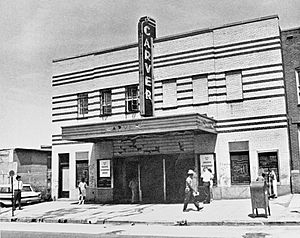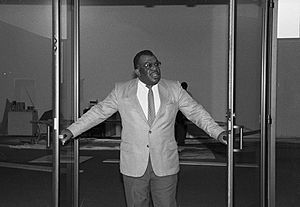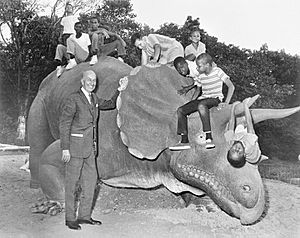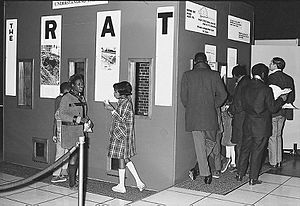Anacostia Community Museum facts for kids
 |
|
 |
|
| Lua error in Module:Location_map at line 420: attempt to index field 'wikibase' (a nil value). | |
| Established | 1967 |
|---|---|
| Location | Washington, D.C. |
| Type | Community museum |
| Visitors | 38,963 (2008) |
| Public transit access | |
The Anacostia Community Museum, also called the ACM, is a special museum in Washington, D.C.. It's located in the Anacostia neighborhood. This museum is part of the famous Smithsonian Institution, which has many museums. In fact, it was the first museum in the United States to be funded by the government and focus on a specific community.
The museum opened in 1967. Its main goal was to bring the exciting exhibits from the Smithsonian museums on the National Mall closer to the people of Anacostia. This way, more community members could enjoy and learn from the Smithsonian's collections. The museum became fully government-funded in 1970. Today, its exhibits focus on the history and culture of the Anacostia area. The museum also has its own library.
Contents
Discovering the Museum's History
How the Museum Started

The Smithsonian Institution first described the Anacostia Community Museum as an "experimental store-front museum" in 1966. The head of the Smithsonian, S. Dillon Ripley, wanted to encourage more African Americans to visit the main Smithsonian museums. This idea came from a meeting held by the Smithsonian in 1966.
In March 1967, the Smithsonian bought the Carver Theater in Anacostia. They wanted the community's help, so local residents formed a council to give advice. John Kinard, a pastor and activist, became the museum's director in June 1967. He made sure that young people from the neighborhood were involved in creating the museum.
Every week, the museum's Neighborhood Advisory Committee, made of community members, met to plan programs and exhibits. Staff and local people worked together to turn the old movie theater into an exhibit space. The community even helped choose which items would be shown.
The Anacostia Neighborhood Museum opened its doors on September 15, 1967. It had eight staff members, but only one was permanent. There were no curators or librarians yet. A life-size model of a Tricerotops dinosaur, later known as "Uncle Beazley" in a children's TV movie, was even at the opening! This dinosaur model is now at the National Zoo.
In 1968, the museum hired a photographer and opened a photo lab. The museum became part of the Smithsonian's official budget in 1970. That same year, the Anacostia Research Center started. It used funding from the Carnegie Corporation to create an oral history program, collecting stories from people.
The museum hired its first historian, Louise Daniel Hutchinson, in 1971. By 1972, the museum had ten full-time staff members. They worked in three main areas: the director's office, education, and research/exhibitions. As the museum grew, it developed new ways to involve the community in planning exhibits. The large Neighborhood Advisory Committee was made smaller and renamed the Board of Directors.

In October 1974, the Exhibits Design and Production Laboratory opened at Fort Stanton (Washington, D.C.). This is where preparations for a new museum building took place. In 1976, a fire broke out there, causing about $75,000 in damage, but no one was hurt.
In 1980, the museum became the first Smithsonian museum to use special labels for the hearing impaired in its exhibits. An archives dedicated to the Anacostia area was created in 1977.
The new Anacostia Museum opened on May 17, 1987, at Fort Stanton. Its name changed because its mission expanded. It now celebrated African American history not just in Anacostia, but worldwide. Sadly, long-time director John Kinard passed away in 1989.
Changes After John Kinard
Steven Newsome, a librarian, became the new museum director in 1991. That same year, the museum opened its own library. The museum changed its name again in 1995 to the Anacostia Museum and Center for African American History and Culture. The idea was for it to become the home for the National Museum of African American History and Culture.
During Newsome's time as director, the museum had a big renovation that cost $8.5 million. Newsome retired in 2004. In 2006, the museum decided to change its focus back to the Anacostia communities. It changed its name once more to the Anacostia Community Museum. That year, Camille Akeju became the new director.
With Camille Akeju, the way exhibits were chosen changed. Before, community members could suggest ideas for exhibits. Now, museum staff and curators choose the exhibition concepts.
Museum Building and Design
The Fort Stanton building, which opened in 1987, was designed by several architecture firms. Its design was meant to fit in with the natural surroundings. The outside of the building is made of red brick patterns that look like kente cloth, a colorful fabric from West Africa. It also has concrete cylinders with glass blocks and blue tiles. These cylinders were inspired by the ancient ruins of Great Zimbabwe. Large windows are at the entrance.
In March 2019, the museum closed for a $4.5 million renovation. It reopened in October 2019, looking fresh and new.
Museum Collections
The Anacostia Community Museum did not have its own permanent collection of objects until the late 1970s. The Smithsonian had not allowed it to build one. At the time, the Smithsonian didn't have many items related to African American history and culture. John Kinard encouraged other museums to start collecting such items, like artwork and things owned by Duke Ellington.
In 1977, the museum was finally able to start building its own permanent collection. The museum library was created in 1991. In 1992, the ACM made its first plan for managing its collections. This plan stated that the museum would focus on items from the Anacostia neighborhood and nearby areas.
In 2003, the museum received the archives of Lorenzo Dow Turner as a gift from his wife. In 2010, an exhibit called Word, Shout, Song: Lorenzo Dow Turner, Connecting Communities Through Language was held to show off this collection. The museum also has a collection of art by artists like James A. Porter, Sam Gilliam, and Benny Andrews.
Exciting Exhibitions
Throughout its history, the museum's exhibits have shown the life of the Anacostia community and other urban areas in the United States. They have also featured African American history and art. Topics have included immigration, slavery, civil rights, and music.
The very first exhibit at the museum in 1967 showed a reproduction of an Anacostia store from 1890. It also had a Project Mercury spacecraft, a theater, a small zoo, and various natural history objects. The small zoo even had a parrot named George, a gift from the National Zoo.
Other early exhibits included The Rat: Man's Invited Affliction in 1969, which looked at rat problems. The museum's bicentennial exhibit, Blacks in the Western Movement, told the stories of African Americans who explored and settled the American west. This exhibit traveled across the country and was even made into a documentary film.
In the early years, community members often helped museum staff, like exhibit designer James E. Mayo, put together the exhibits.
The ACM started working with the Smithsonian Institution Traveling Exhibition Service (SITES) to create traveling exhibits. These were some of the first major African American themed exhibits at the Smithsonian. In 1977, The Anacostia Story showed the history of the neighborhood from 1608 to 1930.
Frederick Douglass, who lived in Anacostia, was the focus of The Frederick Douglass Years. The 1979 exhibit Out of Africa: From West African Kingdoms to Colonization was the first to use items from the museum's growing permanent collection.
The museum closed for about two months in late 1979 and early 1980. It reopened with the exhibit Anna J. Cooper: A Voice from the South. To celebrate the 100th birthday of Franklin D. Roosevelt, the Smithsonian had many events. The ACM organized Mary McLeod Bethune and Roosevelt's Black Cabinet.
Mercer Ellington, the son of Duke Ellington, filmed a public service announcement for the exhibit The Renaissance: Black Arts of the '20s. The ACM also focused on Washington, D.C.'s role in equal and civil rights with To Achieve These Rights: The Struggle for Equal Rights and Self-Determination in the District of Columbia, 1791-1978. The Washington area was highlighted again with Footsteps from North Brentwood, which discussed the history of Prince George's County, Maryland.
In 2006, the ACM exhibit Reclaiming Midwives: Pillars of Community Support, explored the important roles of midwives in African American communities. The ACM also worked with the Mexican Cultural Institute to create The African Presence in Mexico. The 2010 exhibit Word, Shout and Song looked at the work of Lorenzo Dow Turner and the Gullah language.
Learning and Education
The museum began offering special education courses for teachers in 1977. The Museum Education Department also publishes books about African American history. In 1987, the ACM created the Museum Academy Program. This program works with local children throughout the year, helping them learn and explore.
See also
 In Spanish: Museo Comunitario Anacostia para niños
In Spanish: Museo Comunitario Anacostia para niños



